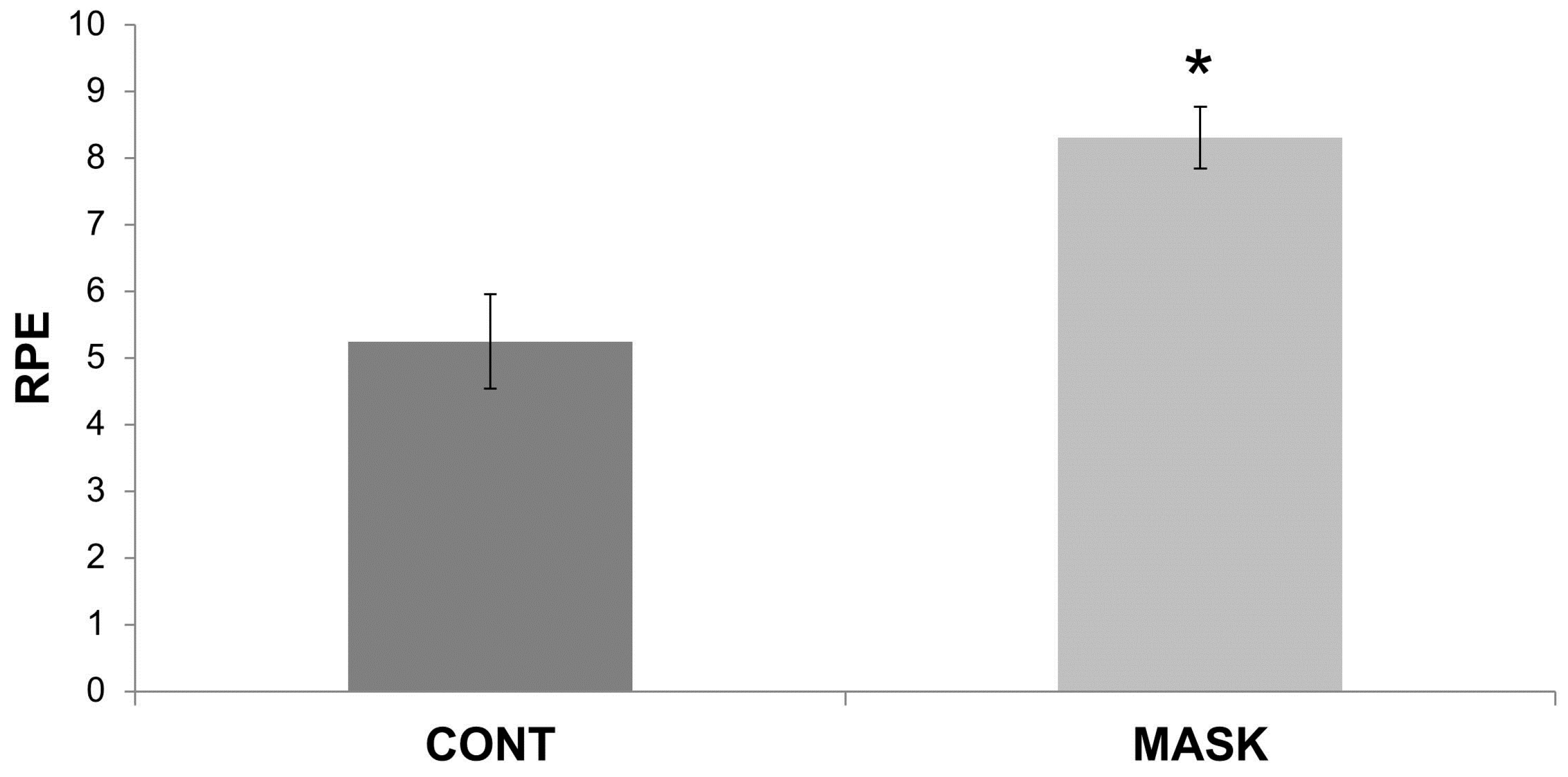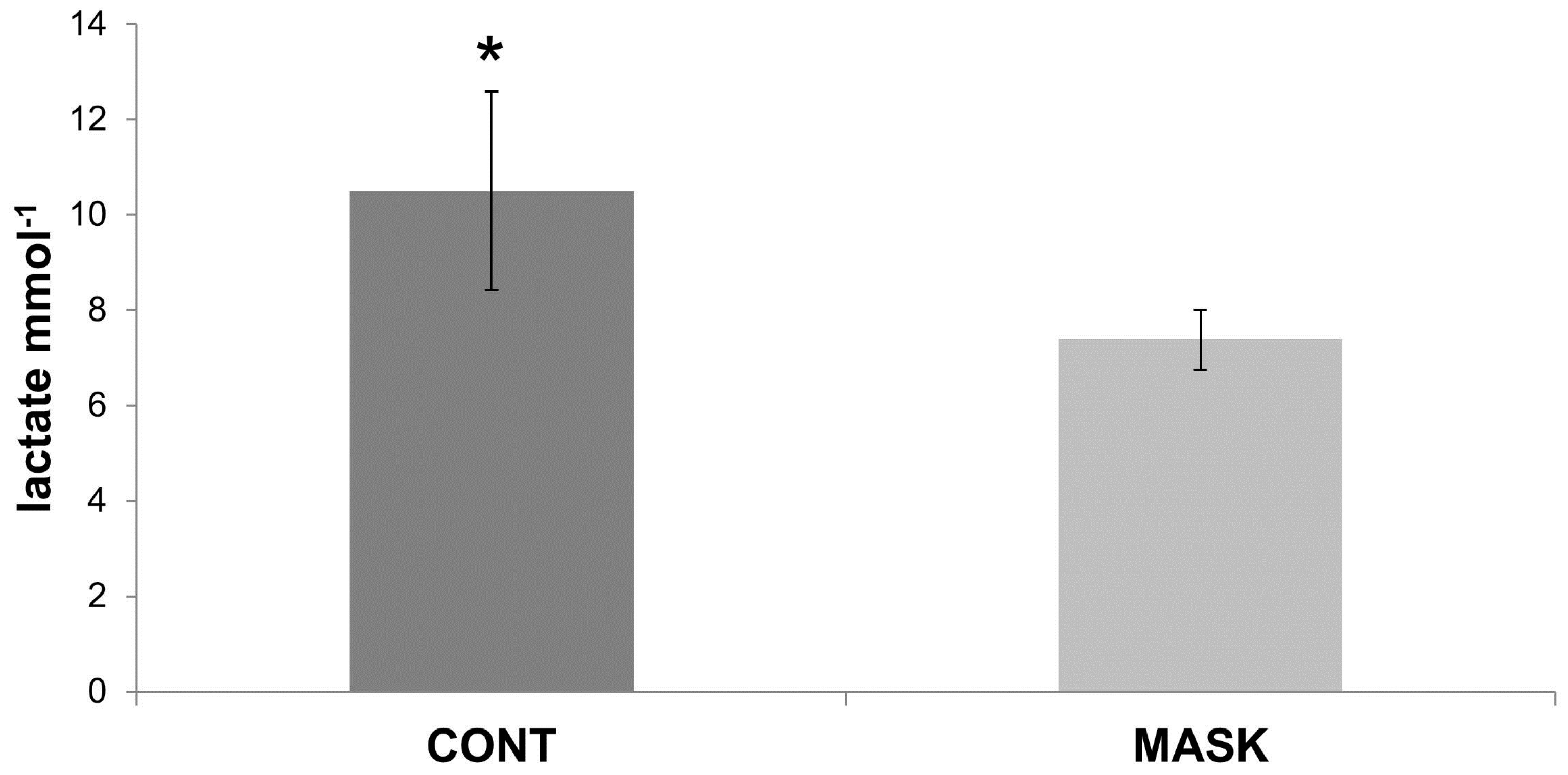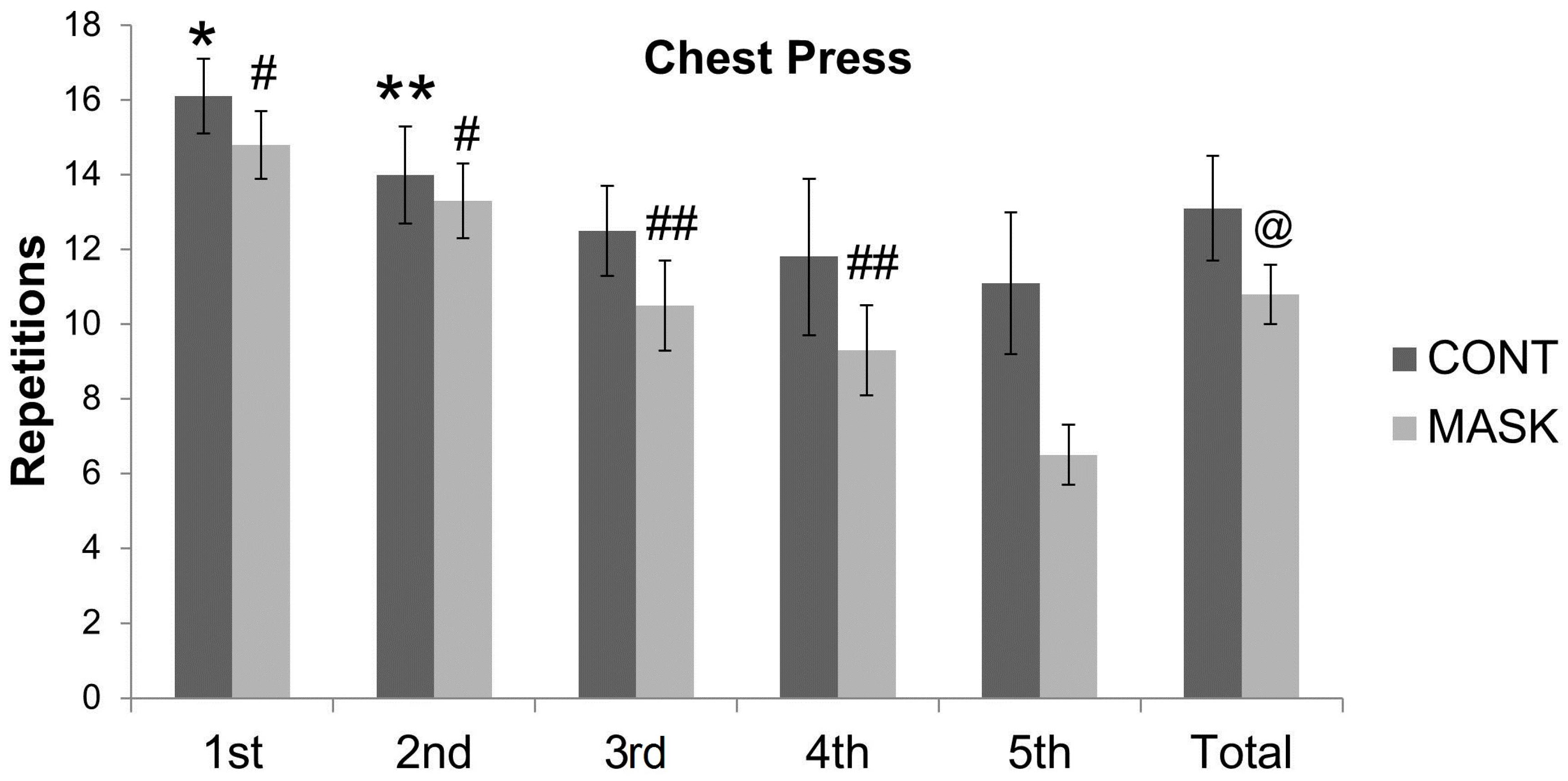Airflow-Restricting Mask Reduces Acute Performance in Resistance Exercise
Abstract
:1. Introduction
2. Materials and Methods
2.1. Participants
2.2. Protocol
2.3. Airflow Restricting Mask Procedures
2.4. Rating of Perceived Exertion
2.5. Lactate Concentration
2.6. Heart Rate
2.7. Statistical Analysis
3. Results
4. Discussion
5. Conclusions
Acknowledgments
Author Contributions
Conflicts of Interest
References
- Schoenfeld, B.J.; Ogborn, D.I.; Krieger, J.W. Effect of repetition duration during resistance training on muscle hypertrophy: A systematic review and meta-analysis. Sports Med. 2015, 45, 577–585. [Google Scholar] [CrossRef] [PubMed]
- Balke, B.; Nagle, F.J.; Daniels, J. Altitude and maximum performance in work and sports activity. JAMA 1965, 194, 646–649. [Google Scholar] [CrossRef] [PubMed]
- Roberts, A.D.; Clark, S.A.; Townsend, N.E.; Anderson, M.E.; Gore, C.J.; Hahn, A.G. Changes in performance, maximal oxygen uptake and maximal accumulated oxygen deficit after 5, 10 and 15 days of live high: Train low altitude exposure. Eur. J. Appl. Physiol. 2003, 88, 390–395. [Google Scholar] [CrossRef] [PubMed]
- Sellers, J.H.; Monaghan, T.P.; Schnaiter, J.A.; Jacobson, B.H.; Pope, Z.K. Efficacy of a ventilatory training mask to improve anaerobic and aerobic capacity in reserve officers' training corps cadets. J. Strength Cond. Res. 2016, 30, 1155–1160. [Google Scholar] [CrossRef] [PubMed]
- Porcari, J.P.; Probst, L.; Forrester, K.; Doberstein, S.; Foster, C.; Cress, M.L.; Schmidt, K. Effect of wearing the elevation training mask on aerobic capacity, lung function, and hematological variables. J. Sports Sci. Med. 2016, 15, 379–386. [Google Scholar] [PubMed]
- Borg, G.A. Psychophysical bases of perceived exertion. Med. Sci. Sports Exerc. 1982, 14, 377–381. [Google Scholar] [CrossRef] [PubMed]
- Koopmans, L.H.; Owen, D.B.; Rosenblatt, J. Confidence intervals for the coefficient of variation for the normal and log normal distributions. Biometrika 1964, 51, 25–32. [Google Scholar] [CrossRef]
- Berben, L.; Sereika, S.M.; Engberg, S. Effect size estimation: Methods and examples. Int. J. Nurs. Stud. 2012, 49, 1039–1047. [Google Scholar] [CrossRef] [PubMed]
- Rosenthal, J.A. Qualitative descriptors of strength of association and effect size. J. Soc. Serv. Res. 1996, 21, 37–59. [Google Scholar] [CrossRef]
- Grissom, R.; Kim, J. Effect Sizes for Research: A Broad Practical Approach; Earlbaum: Mahwah, NJ, USA, 2005. [Google Scholar]
- Hochachka, P.; Beatty, C.; Burelle, Y.; Trump, M.; McKenzie, D.; Matheson, G. The lactate paradox in human high-altitude physiological performance. News Physiol. Sci. 2002, 17, 122–126. [Google Scholar] [PubMed]
- Ploutz-Snyder, L.; Convertino, V.; Dudley, G. Resistance exercise-induced fluid shifts: Change in active muscle size and plasma volume. Am. J. Physiol. Regul. Integr. Comp. Physiol. 1995, 38, R536. [Google Scholar]
- Gehlert, S.; Suhr, F.; Gutsche, K.; Willkomm, L.; Kern, J.; Jacko, D.; Knicker, A.; Schiffer, T.; Wackerhage, H.; Bloch, W. High force development augments skeletal muscle signalling in resistance exercise modes equalized for time under tension. Pflugers Arch. 2015, 467, 1343–1356. [Google Scholar] [CrossRef] [PubMed]
- Messonnier, L.; Kristensen, M.; Juel, C.; Denis, C. Importance of ph regulation and lactate/h+ transport capacity for work production during supramaximal exercise in humans. J. Appl. Physiol. 2007, 102, 1936–1944. [Google Scholar] [CrossRef] [PubMed]
- Lin, H.; Wang, S.W.; Wang, R.Y.; Wang, P.S. Stimulatory effect of lactate on testosterone production by rat leydig cells. J. Cell. Biochem. 2001, 83, 147–154. [Google Scholar] [CrossRef] [PubMed]
- Loenneke, J.P.; Kearney, M.L.; Thrower, A.D.; Collins, S.; Pujol, T.J. The acute response of practical occlusion in the knee extensors. J. Strength Cond. Res. 2010, 24, 2831–2834. [Google Scholar] [CrossRef] [PubMed]
- Crewe, H.; Tucker, R.; Noakes, T.D. The rate of increase in rating of perceived exertion predicts the duration of exercise to fatigue at a fixed power output in different environmental conditions. Eur. J. Appl. Physiol. 2008, 103, 569–577. [Google Scholar] [CrossRef] [PubMed]
- Okano, A.H.; Fontes, E.B.; Montenegro, R.A.; Farinatti, P.T.V.; Cyrino, E.S.; Li, L.M.; Bikson, M.; Noakes, T.D. Brain stimulation modulates the autonomic nervous system, rating of perceived exertion and performance during maximal exercise. Br. J. Sports Med. 2015, 49, 1213–1218. [Google Scholar] [CrossRef] [PubMed]
- Tomczak, S.E.; Guenette, J.A.; Reid, W.D.; McKenzie, D.C.; Sheel, A.W. Diaphragm fatigue after submaximal exercise with chest wall restriction. Med. Sci. Sports Exerc. 2011, 43, 416–424. [Google Scholar] [CrossRef] [PubMed]
- Bishop, D.J. Fatigue during intermittent-sprint exercise. Clin. Exp. Pharmacol. Physiol. 2012, 39, 836–841. [Google Scholar] [CrossRef] [PubMed] [Green Version]
- Gibson, A.S.C.; Baden, D.A.; Lambert, M.I.; Lambert, E.V.; Harley, Y.X.R.; Hampson, D.; Russell, V.A.; Noakes, T.D. The conscious perception of the sensation of fatigue. Sports Med. 2003, 33, 167–176. [Google Scholar] [CrossRef]
- Noakes, T.D. Physiological models to understand exercise fatigue and the adaptations that predict or enhance athletic performance. Scand. J. Med. Sci. Sports 2000, 10, 123–145. [Google Scholar] [CrossRef] [PubMed]




| Control Group | Mean ± SD | CV (%) | P Value | ES | ES-IC | ||||||
|---|---|---|---|---|---|---|---|---|---|---|---|
| 1º × 2º sets | 17.3 ± 1.7 | × | 14.4 ± 1.5 | 9 | and | 12 | 0.004 | –1.71 | –2.48 | to | –0.93 |
| 1º × 3º sets | 17.3 ± 1.7 | × | 12.8 ± 1.7 | 9 | and | 13 | 0.0001 | –2.48 | –3.32 | to | –1.64 |
| 1º × 4º sets | 17.3 ± 1.7 | × | 11.6 ± 1.2 | 9 | and | 10 | 0.0001 | –3.71 | –4.42 | to | –3.00 |
| 1º × 5º sets | 17.3 ± 1.7 | × | 10.6 ± 1.2 | 9 | and | 11 | 0.0001 | –4.36 | –5.07 | to | –3.65 |
| 2º × 4º sets | 14.4 ± 1.5 | × | 11.6 ± 1.2 | 12 | and | 10 | 0.004 | –1.94 | –2.61 | to | –1.28 |
| 2º × 5º sets | 14.4 ± 1.5 | × | 10.6 ± 1.2 | 12 | and | 11 | 0.0001 | –2.61 | –2.54 | to | –1.97 |
| Mask Group | |||||||||||
| 1º × 2º sets | 14.7 ± 1.6 | × | 12.5 ± 1.6 | 10 | and | 12 | 0.0001 | –1.36 | –2.11 | to | –0.55 |
| 1º × 3º sets | 14.7 ± 1.6 | × | 10.5 ± 1.6 | 10 | and | 15 | 0.0001 | –2.58 | –3.34 | to | 1.82 |
| 1º × 4º sets | 14.7 ± 1.6 | × | 8.38 ± 1.4 | 10 | and | 16 | 0.0001 | –4.12 | –4.83 | to | –3.40 |
| 1º × 5º sets | 14.7 ± 1.6 | × | 6.1 ± 1.1 | 10 | and | 18 | 0.001 | –6.03 | –6.69 | to | –5.37 |
| 2º × 4º sets | 12.5 ± 1.6 | × | 8.38 ± 1.4 | 12 | and | 16 | 0.0001 | –2.58 | –3.32 | to | –1.84 |
| 2º × 5º sets | 12.5 ± 1.6 | × | 6.1 ± 1.1 | 12 | and | 18 | 0.0001 | –4.21 | –4.90 | to | –3.52 |
| 3º × 5º sets | 10.5 ± 1.6 | × | 6.1 ± 1.1 | 15 | and | 18 | 0.0001 | –2.86 | –3.55 | to | –2.18 |
| Control Group | Mean ± SD | CV (%) | P value | ES | ES-IC | ||||||
|---|---|---|---|---|---|---|---|---|---|---|---|
| 1º × 3º sets | 16.1 ± 1.0 | × | 12.5 ± 1.2 | 6 | and | 9 | 0.0001 | –3.12 | –3.65 | to | –2.58 |
| 1º × 4º sets | 16.1 ± 1.0 | × | 11.7 ± 2.1 | 6 | and | 18 | 0.0001 | –2.50 | –3.31 | to | –1.69 |
| 1º × 5º sets | 16.1 ± 1.0 | × | 11.1 ± 1.9 | 6 | and | 16 | 0.0001 | –3.13 | –3.87 | to | 2.39 |
| 2º × 5º sets | 14.0 ± 1.3 | × | 11.1 ± 1.9 | 9 | and | 16 | 0.008 | –1.67 | –2.47 | to | –0.88 |
| Mask Group | |||||||||||
| 1º × 3º sets | 14.7 ± 0.9 | × | 10.5 ± 1.2 | 6 | and | 11 | 0.0001 | –3.81 | –4.33 | to | –3.30 |
| 1º × 4º sets | 14.7 ± 0.9 | × | 9.25 ± 1.2 | 6 | and | 12 | 0.0001 | –5.03 | –5.53 | to | –4.52 |
| 1º × 5º sets | 14.7 ± 0.9 | × | 6.5 ± 0.8 | 6 | and | 11 | 0.0001 | –9.42 | –9.83 | to | –9.02 |
| 2º × 3º sets | 13.2 ± 1.0 | × | 10.5 ± 1.2 | 7 | and | 11 | 0.0001 | –3.77 | –4.26 | to | –3.28 |
| 2º × 4º sets | 13.2 ± 1.0 | × | 9.25 ± 1.2 | 7 | and | 12 | 0.0001 | –2.64 | –3.12 | to | –2.16 |
| 2º × 5º sets | 13.2 ± 1.0 | × | 6.5 ± 0.8 | 7 | and | 11 | 0.001 | –2.32 | –2.87 | to | –1.77 |
| 3º × 5º sets | 10.5 ± 1.2 | × | 6.5 ± 0.8 | 11 | and | 11 | 0.0001 | –3.43 | –3.97 | to | –2.89 |
| 4º × 5º sets | 9.25 ± 1.2 | × | 6.5 ± 0.8 | 12 | and | 11 | 0.0001 | –7.00 | –7.45 | to | –6.56 |
© 2016 by the authors; licensee MDPI, Basel, Switzerland. This article is an open access article distributed under the terms and conditions of the Creative Commons Attribution (CC-BY) license (http://creativecommons.org/licenses/by/4.0/).
Share and Cite
Motoyama, Y.L.; Joel, G.B.; Pereira, P.E.A.; Esteves, G.J.; Azevedo, P.H.S.M. Airflow-Restricting Mask Reduces Acute Performance in Resistance Exercise. Sports 2016, 4, 46. https://doi.org/10.3390/sports4040046
Motoyama YL, Joel GB, Pereira PEA, Esteves GJ, Azevedo PHSM. Airflow-Restricting Mask Reduces Acute Performance in Resistance Exercise. Sports. 2016; 4(4):46. https://doi.org/10.3390/sports4040046
Chicago/Turabian StyleMotoyama, Yuri L., Gustavo B. Joel, Paulo E. A. Pereira, Gilmar J. Esteves, and Paulo H. S. M. Azevedo. 2016. "Airflow-Restricting Mask Reduces Acute Performance in Resistance Exercise" Sports 4, no. 4: 46. https://doi.org/10.3390/sports4040046
APA StyleMotoyama, Y. L., Joel, G. B., Pereira, P. E. A., Esteves, G. J., & Azevedo, P. H. S. M. (2016). Airflow-Restricting Mask Reduces Acute Performance in Resistance Exercise. Sports, 4(4), 46. https://doi.org/10.3390/sports4040046






